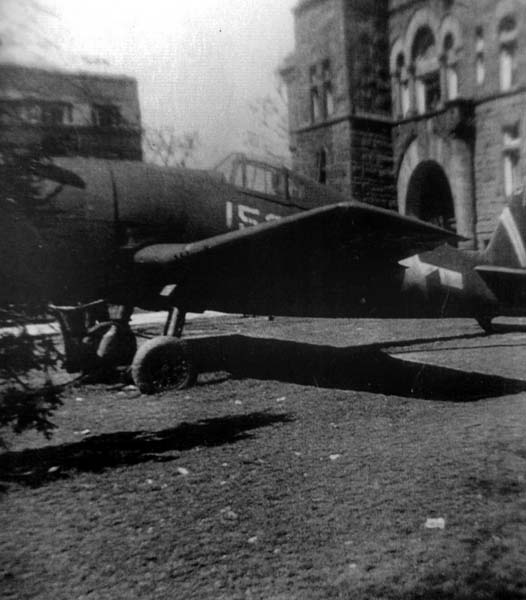Philippi’s White Elephant
By Steve Weaver

The F6F Hellcat on the grounds of the Barbour County Courthouse. Photo courtesy of Steve Weaver.
After World War II, in a great rush of patriotic pride and zeal, thousands of towns and cities across the United States accepted various icons of the war. These were usually howitzers, tanks, ack-ack guns, or some other deadly artifact that would lend itself to a civic display and honor our brave service men and women. The U.S. War Department was bulging with leftover, obsolete articles of war and, frankly, was running out of places to store them. Washington was only too glad to have someone else take responsibility for its growing pile of stuff.
To a lesser extent, this was also done after World War I. The courthouse lawn in Philippi is still home to a German machine gun from the Great War, E. M. Viquesney’s Spirit of the Doughboy statue (“Iron Mike”), and a bronze tablet with the names of the Barbour County men who gave their lives in that war. I’m pretty sure, though, that the commissioners after the second war wished they’d chosen something as compact as a machine gun. As it turned out, they got an airplane.
The plane arrived at Benedum Airport (now West Virginia North Central Airport) in nearby Bridgeport during the summer of 1947. It was a nearly perfect F6F Hellcat fighter, one of 12,275 produced by Grumman between 1942 and 1945 as an answer to Japan’s highly effective A6M Zeros. The Department of the Navy flew in the Hellcat and presented it to the city of Philippi. A local coal operator provided use of a lowboy trailer and tractor. The plane’s 43-foot wings were folded up before being loaded onto the trailer and then trucked 20 miles to Philippi, where it was installed on the lawn in front of the courthouse.
County officials had probably seen a picture of the Hellcat in a listing of war leftovers from the War Department, but until the plane was set in place, no one realized how incredibly big the darn thing was. It was positioned on the right side of the courthouse square, as far back as possible, but its presence made that side of the lawn unusable for anything else. Each fall, the county fair was held on the courthouse grounds, and the plane was right where several booths had always been.
In addition, the plane took a physical toll on the grounds. The courthouse maintenance man complained about the grass dying underneath the behemoth—accelerated by a steady drip of oil from the plane’s huge radial engine—and about the challenge of trimming the grass around the plane. Several other folks grumbled about it being an eyesore. Our monument wasn’t really working out.
On the other hand, my seven-year-old self thought I’d died and gone to heaven. I’d already developed a fascination with planes. [See “The Runaway Airplane” by Steve Weaver in our Spring 2010 issue]. Here was an actual plane I could walk up to and touch anytime I could cadge a trip to town with my dad. It seemed surreal.
Our home was in the tiny hamlet of Arden, some nine miles down the Tygart River from Philippi. At age seven, my lifelong (a relative term here) love affair with aviation had remained achingly unconsummated while watching the sky from our home. No one else in my family had even a passing interest in planes, so the origin of my passion for things aeronautical was a mystery, apparently a misalignment of genes at birth.
I pursued my budding interest mostly by watching J-3 and Taylorcraft planes from the Philippi airport, flown by Hoy Mitchell Jr. and other GI Bill students from the Arden area, buzzing their parents’ homes. But that was about the extent of it. Now, here was this beautiful Grumman fighter that I’d already read about in flying magazines—ones Hoy had handed down to me. I knew all its specifications, its speed, and its fighting history. I couldn’t get enough of the Hellcat during our infrequent visits to Philippi. I should note here that being a good West Virginia boy, I wasn’t allowed to say “hell,” even when it was part of a proper name, so I referred to it only as “The Airplane”—at least in front of my mom and dad. They knew which airplane I meant.
available in bookstores, libraries or direct from Goldenseal.